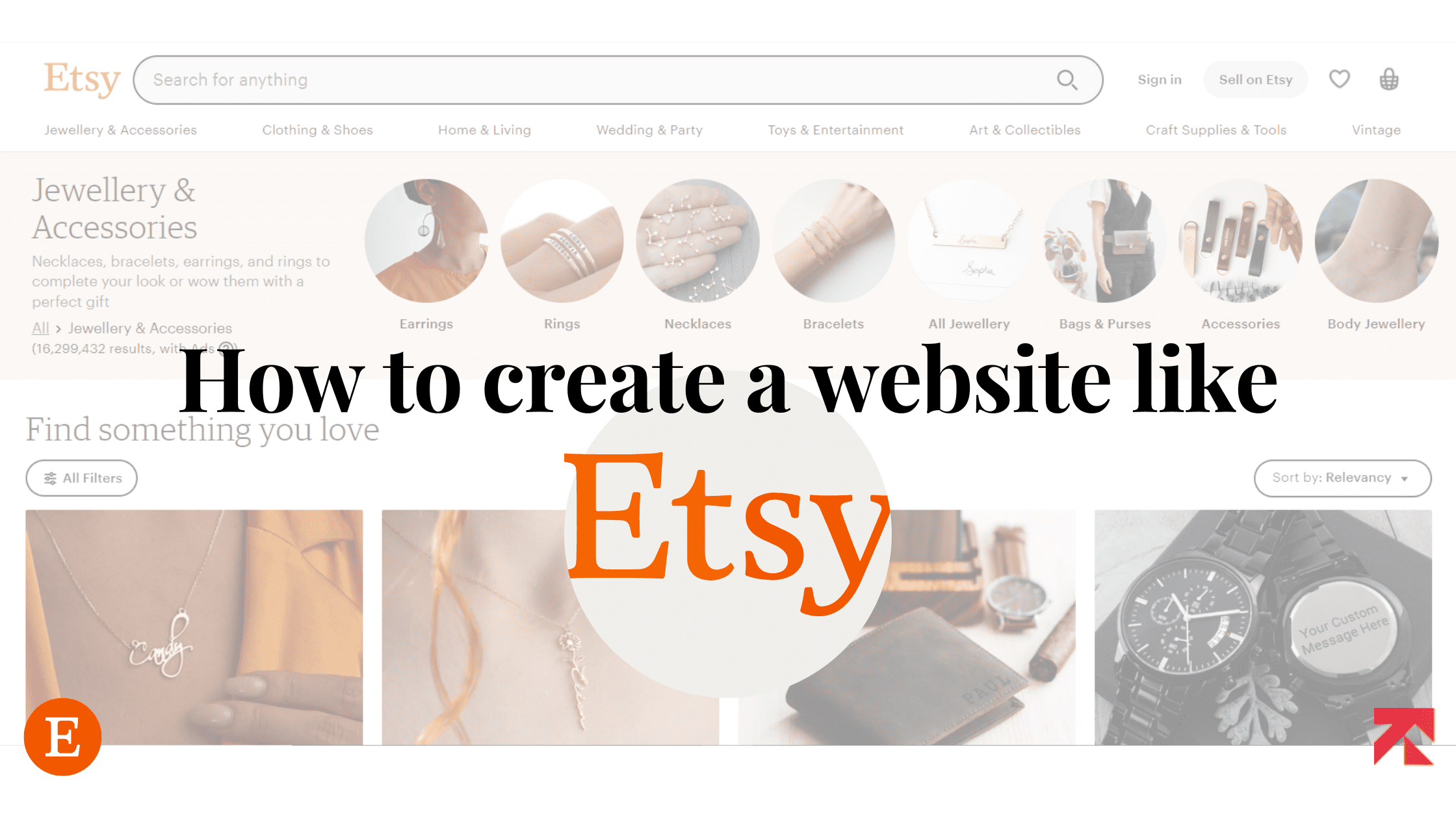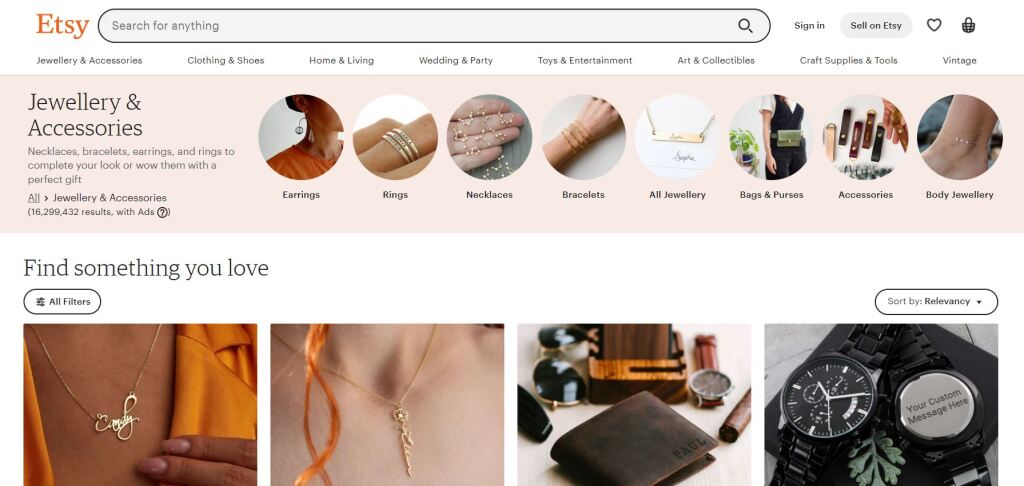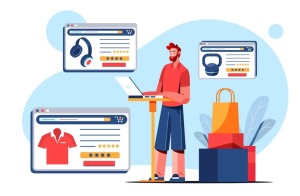admin

Table Of Contents
Online marketplaces have become increasingly popular over the years, with many people opting to buy and sell goods through the internet. One such that has gained immense popularity is Etsy; a marketplace that connects buyers and sellers of handmade, vintage, and unique items. Its success prompted many entrepreneurs and eCommerce evangelists to create a website like Etsy but it isn’t as easy as it sounds!
It takes a lot of thought process, budget, creativity, business ingeniousness and strategy to build a website like Etsy. An eCommerce development company is sure to help you out whereas, the details below would serve as a professional guide when it comes to create a website like Etsy. Let’s learn a little about the marketplace first.
Table Of Contents
Etsy is a popular online marketplace that has become a go-to destination for people looking to buy and sell handmade or vintage goods. It was founded in 2005 by Rob Kalin, Chris Maguire, and Haim Schoppik, and has since grown into a thriving community of over 81 million buyers and sellers worldwide.
Etsy’s origins can be traced back to 2005 when Rob Kalin, a painter, and furniture maker, was looking for an online marketplace to sell his handmade goods. Frustrated with the lack of options available, he decided to create his own website, which he called Etsy. The name Etsy is derived from the Italian word “etsi”, which means “oh, yes”.
Kalin’s vision for Etsy was to create a platform where artists and crafters could sell their unique, handmade creations to a global audience. He wanted to provide a space where artisans could connect with buyers directly, without the interference of middlemen or mass-produced goods.
Etsy’s early years were marked by slow growth and financial instability. In 2006, the company received a $50,000 investment from a group of angel investors, which helped them expand their team and improve the platform. However, it wasn’t until 2007 that Etsy really took off, thanks in part to a viral marketing campaign that spread the word about the site to a wider audience.
By 2008, Etsy had become profitable and had attracted a community of dedicated sellers who were committed to the platform’s ethos of handmade and vintage goods. In 2010, Etsy launched its mobile app, which allowed buyers and sellers to access the platform from their smartphones and tablets. This move helped Etsy reach a wider audience and cemented its position as a leader in the eCommerce industry.
Over the years, Etsy has continued to evolve and adapt to the changing needs of its community. In 2013, the company went public, raising $267 million in its initial public offering. Since then, Etsy has expanded its offerings to include custom-made items and digital downloads, and has launched several initiatives to support sustainability and social responsibility.
Today, Etsy is a global marketplace with over 4.4 million active sellers and 81.9 million active buyers in nearly every country in the world. The platform generates billions of dollars in annual sales and has become a go-to destination for people looking for unique, handmade, and vintage items.

Online selling sites like Etsy are digital marketplaces that connect buyers and sellers of handmade, vintage, and unique items. Like Etsy, an Etsy-like website would offer a platform for sellers to showcase their products and for buyers to purchase them. These websites typically allow sellers to set up a store, list their products, and manage orders, while buyers can browse and purchase products from multiple sellers.
Etsy has several features that have contributed to its success. These are:
Creating shopping sites like Etsy can be a complex process, but with the right tools and resources, it is achievable. Here are some steps you can follow to create an Etsy-like website:
There are several eCommerce platforms available that can be used to create an online marketplace. Some popular options include WooCommerce, Magento, and Shopify. Choose a platform that suits your needs and budget.
Once you’ve chosen a platform, you’ll need to set up your website. This will involve choosing a domain name, setting up hosting, and customizing your website’s design.
Most eCommerce platforms have marketplace plugins that can be installed to create an online marketplace. These plugins will allow you to set up seller accounts, product listings, and payment processing.
Once you’ve installed the marketplace plugin, you can customize your marketplace to suit your needs. This may involve setting up categories, creating policies for sellers, and adjusting commission rates.
Once your marketplace is set up, you can launch it and start promoting it to potential buyers and sellers.
Building successful sites like eBay and Etsy requires more than just setting up a website. Here are some tips to help you build a successful online marketplace:
Etsy has over 81 million active users and is a great place for creative individuals to showcase their products and earn money. However, like any business venture, making money on Etsy requires effort, strategy, and dedication. Here’re a few tips and strategies on how to make money with a website like Etsy.
Choosing the right niche is crucial for success on Etsy. You need to identify a product or service that has high demand and low competition. Some popular niches on Etsy include handmade jewelry, home decor, wedding accessories, and personalized gifts. Do some research on Etsy and other selling sites like Etsy to find out what products are popular and in demand.
To stand out from the competition, you need to create a unique brand and style. This involves developing a distinct voice, aesthetic, and personality for your brand. Make sure your brand identity is consistent across all your marketing channels, including your Etsy shop, social media, and website.
Optimizing your Etsy shop is crucial to attract potential customers and increase sales. Here are some tips on how to optimize your shop:
Promoting your products is essential to attracting potential customers and increasing sales. Here are some tips on how to promote your products:
This step is also crucial in building a loyal customer base and growing your business. Here are some tips on how to provide excellent customer service:
If you’re looking to build a website like Etsy, you’ll need a technology stack that can handle the demands of a large online marketplace.
The front-end of a website is what users see and interact with. The technologies that are commonly used for front-end development are:
HTML (HyperText Markup Language), CSS (Cascading Style Sheets), and JavaScript are the basic building blocks of front-end development. The HTML is used for creating the structure of a webpage, CSS is used for styling it, and JavaScript is used for adding interactive features.
React.js is a JavaScript library that is commonly used for building user interfaces. It’s known for fast rendering speed, efficient performance, and modular architecture. React.js can be used to build reusable UI components that can be easily integrated into different parts of a website.
Redux is a predictable state container for JavaScript apps. It can be used with React.js to manage the state of a complex application. Redux makes it easier to debug and test an application by keeping the state in one place.

The back-end of a website is responsible for handling the server-side logic and database management. The technologies that are commonly used for back-end development are:
Node.js is a JavaScript runtime that allows developers to build scalable and fast back-end applications. It’s known for its event-driven architecture and non-blocking I/O operations. Node.js is commonly used with the Express.js framework for building APIs and server-side applications.
MongoDB is a popular NoSQL database that is commonly used for storing unstructured data. It’s known for its scalability, flexibility, and ease of use. MongoDB can be used with Node.js to build fast and responsive back-end applications.
GraphQL is a query language that allows developers to define the structure of the data they need from an API. It provides a more efficient and flexible alternative to REST APIs. GraphQL can be used with Node.js and MongoDB to build a scalable and flexible back-end architecture.
DevOps is the practice of combining software development and IT operations to ensure faster and more reliable software delivery. The technologies that are commonly used for DevOps are:
Docker is a containerization platform that allows developers to package their applications and dependencies into a single container. Containers provide a lightweight and portable way to run applications across different environments.
Kubernetes is a container orchestration platform that allows developers to automate the deployment, scaling, and management of containerized applications. It provides a flexible and scalable way to manage containers across different environments.
Jenkins is an open-source automation server that allows developers to automate the software delivery process. It provides a powerful set of plugins and integrations that can be used to automate building, testing, and deploying applications.
So what are the core features of Etsy like marketplaces that make them so successful? Let’s find out!
The registration process of an Etsy-like website should be simple and user-friendly, making it easy for sellers to sign up and start selling their products without any technical knowledge. The registration process should ask for only essential information such as name, email, and address. After registration, the seller should be able to set up their store and start uploading their products.
Customization is one of the essential features of an online marketplace. A seller should be able to create a unique storefront that represents their brand and products. The storefront should allow sellers to upload their logo, banner images, product images, and descriptions. It should also let sellers add categories, tags, and pricing options.
Product listing is the backbone of an online marketplace which means that the page should be easy to navigate, and the products displayed in a clear and organized manner. The product listing should include high-quality images, short product descriptions, pricing, and shipping information.
A website like Etsy should have a payment gateway integration that allows sellers to receive payments easily. The payment gateway should be secure, reliable, and fast. Etsy uses a payment system called Etsy Payments that accepts credit cards, PayPal, and other payment options. This allows sellers to receive payments from buyers anywhere, conveniently.
An order management system allows sellers to manage their orders, process payments, and keep track of their inventory. It also lets buyers track their orders and receive updates on the status of their orders. Etsy has an order management system that allows sellers to manage their orders and communicate with buyers through the platform.
Customer reviews are buyers’ reviews, ratings and experiences they’ve had with their order, all the way from landing on the website to finding the product, placing an order, buying and receiving. Their experiences and feedback are shared with the sellers to help them improve their service. Etsy has a robust review system that allows buyers to leave feedback on products and sellers.
A sense of community is crucial which interlinks buyers, allows sharing ideas, and collaborate on projects. Community features can include forums, blogs, social media integration, and messaging systems. Etsy has a vibrant community of sellers and buyers who share ideas and support each other.
Mobile compatibility is a must for any online marketplace as more and more people are using their smartphones and tablets to shop online. A website like Etsy should have a responsive design that’s optimized for mobile devices, making it easier for buyers to shop on the go and for sellers to manage their stores from anywhere, anytime.

If you are planning to create a website like Etsy, the first thing you will need to consider is the cost of building and running such a platform. This includes the expenses associated with website development, hosting, maintenance, marketing, and more.
Depending on your preferences, you can either build your own platform from scratch or use an existing eCommerce platform to get started. If you decide to build your marketplace from scratch, the cost could range from $10,000 to $50,000, depending on the complexity of the platform and the experience of the developers. However, using a ready-made eCommerce platform like Magento, WooCommerce or Shopify could cost you between $5,000 to $20,000.
Once you have decided on the development platform, you will need to create a design that can be done either by hiring an eCommerce design and development company or a professional web designer to create a custom design, or you can use a pre-made template. A custom design could cost you anywhere from $5,000 to $15,000, while a pre-made template may cost anywhere between $100 to $300.
The cost of hosting and domain name registration can vary significantly based on the traffic and size of your marketplace. A basic shared hosting plan could cost anywhere between $3 to $10 per month, while a VPS or dedicated server could cost upwards of $100 per month. The cost of domain name registration typically ranges from $10 to $15 per year.
To facilitate transactions on your marketplace, you will need to integrate a payment gateway into your platform. The cost of integrating a payment gateway can vary depending on the provider you choose. Some popular payment gateway providers include PayPal, Stripe, and Braintree. The integration cost for a payment gateway can range from $500 to $2,000.
The cost of integrating various features into your marketplace will depend on the complexity of the features you wish to include. Some common features of an online marketplace include product search, browsing, filtering, and sorting; user profiles, reviews and ratings; and messaging systems. The cost of integrating these features can range from $5,000 to $10,000.
Marketing and advertising are essential to attract customers to your marketplace. Depending on your budget and marketing strategy, the cost of marketing and advertising can vary. Paid advertising through Google AdWords, Facebook Ads, or other platforms could cost you anywhere from $500 to $10,000 per month. Other marketing strategies such as content marketing, social media marketing, and influencer marketing may also add up to your marketing expenses.
Once your marketplace is up and running, you will need to maintain and support it. This includes regular updates, bug fixes, and server maintenance. The cost of maintenance and support can vary based on the complexity of your platform and the level of support you require. A basic support package could cost you anywhere from $50 to $500 per month.
There are a few key steps you’ll need to take to create a successful online website like Etsy.

The first step in creating a marketplace like Etsy is to identify the niche you want to target. Etsy has become famous for its focus on handmade, vintage, and unique items. Still, there are many other potential niches that you could target, such as artisanal foods, custom-made clothing, or home goods. Whatever niche you choose, it’s essential to ensure that there is enough demand for your products to support a thriving marketplace.
Creating a successful marketplace requires a well-thought-out business plan. Yours should include a detailed overview of your marketplace, including its target audience, business operational model, revenue streams, and marketing strategy. Consider factors such as website design, user experience, and seller fees when developing your business plan.
Once you have a solid business plan in place, it’s time to build your marketplace. You will need to create a website that is user-friendly, visually appealing, and secure. You’ll also need to consider how users will buy and sell products on your marketplace. Choose a platform that has the features you need to support your business model, such as inventory management, payment processing, and shipping tracking.
A successful marketplace relies on a steady supply of quality products from sellers. To attract sellers to your marketplace, you’ll need to create a compelling value proposition that includes benefits such as low seller fees, access to a large audience, and marketing support. You may also consider targeting specific sellers that align with your niche or offering incentives for sellers to join your marketplace.
Trust and safety are critical to the success of any marketplace. You’ll need to establish policies and procedures to ensure that buyers and sellers feel safe when using your platform. This may include verifying seller identities, providing secure payment processing, and offering buyer protection policies. Make sure to communicate your safety and trust policies clearly to both buyers and sellers.
Once your marketplace is up and running, it’s time to start promoting it. Use social media, email marketing, and advertising to reach potential buyers and sellers. You may also consider offering incentives for buyers to purchase products or referring new sellers to your platform. As your marketplace grows, you can also explore partnership opportunities with other businesses or influencers in your niche.
Creating a website like Etsy takes time, effort, and dedication. However, with the right business plan, platform, and marketing strategy, you can build a successful online marketplace that connects buyers and sellers around the world. Let the details above serve you as a guide to create an online marketplace like Etsy. Good luck!
Table Of Contents

